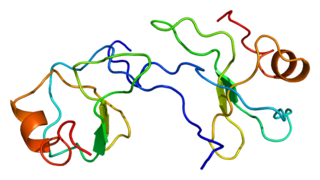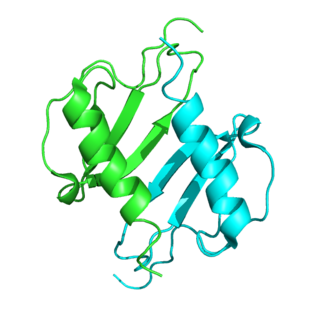
For the ICAO airport code see Candle Lake Airpark, for the diradical compound see Dichlorocarbene.

Chemokine ligand 5 is a protein which in humans is encoded by the CCL5 gene. The gene has been discovered in 1990 by in situ hybridisation and it is localised on 17q11.2-q12 chromosome. It is also known as RANTES. RANTES was first described by Dr. Tom Schall who named the protein, the original source of the name Rantes was from the Argentine movie Man Facing Southeast about an alien who shows up in a mental ward who was named Rantés, the rather clunky acronym was only made to fit the name.

Chemokine ligand 3 (CCL3) also known as macrophage inflammatory protein 1-alpha (MIP-1-alpha) is a protein that in humans is encoded by the CCL3 gene.

Chemokine ligand 7 (CCL7) is a small cytokine that was previously called monocyte-chemotactic protein 3 (MCP3). CCL7 is a small protein that belongs to the CC chemokine family and is most closely related to CCL2.

Chemokine ligand 8 (CCL8), also known as monocyte chemoattractant protein 2 (MCP2), is a protein that in humans is encoded by the CCL8 gene.

C-X-C motif chemokine 5 is a protein that in humans is encoded by the CXCL5 gene.

C-C chemokine receptor type 2 (CCR2 or CD192 is a protein that in humans is encoded by the CCR2 gene. CCR2 is a CC chemokine receptor.

C-C chemokine receptor type 1 is a protein that in humans is encoded by the CCR1 gene.

Chemokine receptor 6 also known as CCR6 is a CC chemokine receptor protein which in humans is encoded by the CCR6 gene. CCR6 has also recently been designated CD196. The gene is located on the long arm of Chromosome 6 (6q27) on the Watson (plus) strand. It is 139,737 bases long and encodes a protein of 374 amino acids.

Chemokine like receptor 1 also known as ChemR23 is a protein that in humans is encoded by the CMKLR1 gene. Chemokine receptor-like 1 is a G protein-coupled receptor for the chemoattractant adipokine chemerin and the omega-3 fatty acid eicosapentaenoic acid-derived specialized pro-resolving molecule, resolvin E1. The murine receptor that shares almost 80% homology with the human receptor, is called Dez.

G protein-coupled receptor 1, also known as GPR1, is a protein that in humans is encoded by the GPR1 gene.

C-C chemokine receptor type 10 is a protein that in humans is encoded by the CCR10 gene.

C-C chemokine receptor type 4 is a protein that in humans is encoded by the CCR4 gene. CCR4 has also recently been designated CD194.

C-C chemokine receptor type 3 is a protein that in humans is encoded by the CCR3 gene.

C-C chemokine receptor type 9 is a protein that in humans is encoded by the CCR9 gene.

C-C chemokine receptor type 11 is a protein that in humans is encoded by the CCRL1 gene.

Chemokine-binding protein 2 is a protein that in humans is encoded by the CCBP2 gene.

Interleukin 17 receptor A, also known as IL17RA and CDw217, is a human gene.

Chemokine-like factor (CKLF) is a member of the CKLF-like MARVEL transmembrane domain-containing family of proteins that in humans is encoded by the CKLF gene. This gene is located on band 22.1 in the long arm of chromosome 16.

CD300A is a human gene.

















